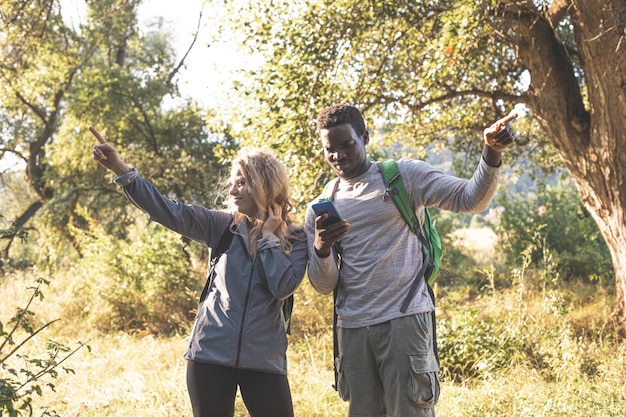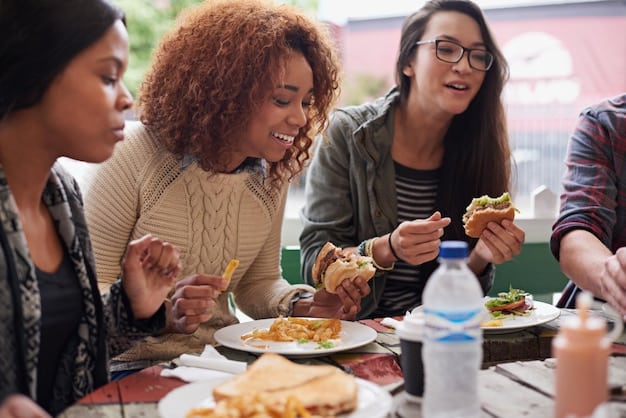The Power of Shared Experiences: Deepening Connections

The power of shared experiences fundamentally transforms and strengthens human relationships by fostering mutual understanding, emotional resonance, and lasting memories that serve as enduring foundations for deeper bonds.
The Power of Shared Experiences: How Creating Memories Together Can Deepen Your Connection is a profound concept, essential for nurturing robust and meaningful relationships. This exploration delves into how engaging in activities and moments together transcends mere interaction, building a tapestry of shared understanding, empathy, and enduring affection.
The Intrinsic Value of Shared Moments
Shared experiences are not simply ephemeral events but are foundational pillars upon which strong, resilient relationships are built. When individuals engage in an activity together, be it a grand adventure or a quiet evening at home, they are not just passing time. They are, in fact, co-creating a narrative, a unique story that belongs solely to them. This narrative forms a private language, built on inside jokes, shared challenges overcome, and moments of pure, unadulterated joy or profound sorrow.
This process of co-creation fosters a sense of exclusivity and belonging. It differentiates the relationship from others, giving it a unique texture and depth that cannot be replicated. It is in these shared moments that vulnerabilities are often revealed, trust is solidified, and laughter echoes, weaving an intricate pattern of interdependence and affection.
Beyond the Surface: Emotional Resonance
The true power of shared experiences lies in their capacity to generate emotional resonance. It’s not merely about ‘doing something’ but about ‘feeling something’ together. When emotions are shared—whether they are excitement during a concert, awe during a natural phenomenon, or comfort in a quiet embrace—they create a powerful, enduring bond. This synchronous emotional experience imprints itself on the memory, creating vivid recollections that can be revisited and re-experienced, reinforcing the connection over time.
- Synchronized Emotions: Experiencing joy, awe, or even sorrow simultaneously deepens empathy.
- Memory Anchors: Shared moments serve as emotional anchors, providing comfort and stability.
- Reduced Isolation: Knowing someone else experienced the same profound feeling can mitigate feelings of loneliness.
This emotional synchronicity is a vital component of fostering intimacy. It allows individuals to see and understand their partner’s emotional landscape more clearly, leading to greater empathy and a more profound sense of connection. It’s about being present with another person, truly seeing them and being seen, and acknowledging the depth of their human experience.
Ultimately, shared moments act as catalysts for profound connection. They move relationships beyond the superficial, allowing for genuine, heartfelt interaction and understanding. The memories forged in these moments become invaluable assets, providing a rich narrative that defines and strengthens the bond between individuals. They are the stories we tell, the laughter we recall, and the quiet understanding that only shared history can provide.
Building a Shared Narrative: The Foundation of Connection
Every relationship, much like a good book, thrives on its narrative. Shared experiences are the chapters, paragraphs, and even the punctuation marks that make up this unique story. By engaging in diverse activities together, individuals aren’t just accumulating events; they are actively constructing a unique history that becomes the bedrock of their connection. This shared narrative is more than a chronological list of dates; it’s a tapestry woven with inside jokes, challenges overcome, triumphs celebrated, and quiet moments of understanding. It builds a distinct relational identity that sets one bond apart from all others.
Think of it as developing a unique language that only you and your partner understand. This language is composed of shared memories, unspoken cues, and a rich context that only those who have lived through the experiences together can truly grasp. It creates a sense of belonging and exclusivity, solidifying the idea that “we are in this together,” reinforcing loyalty and commitment.
Overcoming Challenges Together: Resilience Through Adversity
While shared joys are undoubtedly vital, confronting and overcoming challenges together often provides an even more profound boost to a relationship’s resilience. These moments of adversity, when navigated as a team, forge a powerful sense of unity and mutual reliance. Whether it’s a difficult move, a financial setback, or a personal crisis, facing these trials side-by-side demonstrates commitment, trust, and unwavering support. The shared experience of perseverance strengthens the bond, proving that the relationship can withstand external pressures.
It’s during these trying times that true characters are often revealed, and the depth of care and commitment becomes unmistakably clear. The relief and pride that follow the resolution of a shared challenge further solidify the connection, transforming obstacles into shared victories. These experiences become touchstones, points of reference that remind both individuals of their capacity to overcome anything, as long as they face it together.
- Increased Trust: Overcoming obstacles together builds confidence in each other’s reliability.
- Enhanced Communication: Adversity often necessitates deeper, more honest dialogue.
- Strengthened Empathy: Witnessing a partner’s struggles and supporting them fosters profound empathy.
The shared narrative isn’t just about what happened, but also about how it felt, and how those feelings were processed together. It’s about the unspoken understanding, the comforting gestures, and the collective sighs of relief. These moments, both good and challenging, weave a complex, durable fabric of shared history, making the relationship richer, more resilient, and deeply meaningful. This ongoing narrative is a dynamic, living entity that grows and evolves with every new shared experience, continually deepening the connection between individuals.

The Neuroscience of Togetherness: How Shared Experiences Rewire Our Brains
The impact of shared experiences extends far beyond emotional resonance; it literally influences our neural pathways. When we engage in activities with others, especially those that evoke strong emotions, our brains undergo subtle but significant changes. This phenomenon, often referred to as “neural coupling” or “brain synchrony,” suggests that the brains of individuals sharing an experience can align their activity patterns. This synchronization enhances empathy, understanding, and a sense of unity.
Consider the release of oxytocin, often dubbed the “love hormone,” during positive shared experiences. Activities like intimate conversations, shared laughter, or even cooperative tasks can trigger oxytocin release, which plays a crucial role in promoting bonding, trust, and feelings of attachment. This biochemical response reinforces the positive feelings associated with the shared moment, encouraging individuals to seek out more such interactions.
Moreover, shared experiences contribute to the formation of “flashbulb memories” – vivid, long-lasting recollections of significant events. While traumatic events often form such memories, deeply positive, shared experiences can also etch themselves into our minds with remarkable clarity. These powerful memories serve as anchors in a relationship, providing a rich archive of common ground and reminding individuals of their joint journey.
Mirror Neurons and Empathetic Connection
A fascinating aspect of the neuroscience of togetherness involves mirror neurons. These specialized brain cells activate both when an individual performs an action and when they observe someone else performing the same action. In the context of shared experiences, mirror neurons are thought to play a vital role in empathy and understanding. When we witness a loved one’s joy, pain, or excitement during a shared activity, our mirror neurons fire, allowing us to “feel” what they are feeling to some extent. This neural mechanism facilitates a deeper, more intuitive understanding of another person’s emotional state, fostering empathy and strengthening emotional bonds.
- Neural Synchrony: Brain activity aligning during shared activities enhances understanding.
- Oxytocin Release: Promotes bonding, trust, and feelings of attachment, reinforcing positive interactions.
- Mirror Neuron Activation: Facilitates empathy by allowing us to “feel” another’s emotions, deepening connection.
This biological underpinning highlights why shared experiences are so potent. They do not just create social connections; they create neural connections, literally wiring us to feel more in tune with those with whom we share significant moments. This intricate interplay between external experiences and internal biological responses underscores the profound and transformative power of togetherness, illustrating how creating memories together is not just a pleasant pastime, but a fundamental human need that shapes our brains and strengthens our most cherished relationships.
Practical Approaches to Creating Meaningful Shared Experiences
While the benefits of shared experiences are clear, intentionally creating them can sometimes feel daunting amidst busy lives. The key lies not in grand gestures but in consistent, thoughtful efforts. Meaningful shared experiences don’t always require lavish trips or expensive outings; they often emerge from simple, everyday moments intentionally infused with presence and connection. The goal is to cultivate a mindset that values togetherness and seeks opportunities to engage authentically.
Start by identifying common interests or curiosities. Is there a new skill you both want to learn? A local park you’ve never explored? A type of cuisine you both enjoy? These shared points of interest can serve as launchpads for new adventures. The focus should be on the process of discovery and enjoyment together, rather than solely on the outcome of the activity itself. This intentionality shifts the dynamic from merely “doing something” to “building something” together.
Beyond the Ordinary: Embracing Novelty and Adventure
While routine shared moments are comforting, incorporating novelty and adventure can significantly amplify the power of shared experiences. Trying new things together stimulates the brain, creates unique memories, and can even reignite a sense of excitement and spontaneity in a relationship. This doesn’t mean you need to become extreme sports enthusiasts overnight; novelty can come in many forms.
- Explore a new neighborhood monthly: Discover new shops, cafes, or walking paths together.
- Attempt a new recipe weekly: Transform cooking into a collaborative and potentially humorous adventure.
- Attend local cultural events: Concerts, art exhibits, or community festivals offer fresh perspectives.
- Learn a basic phrase in a new language: Practice together, making it a playful, ongoing shared goal.
The element of novelty often creates a sense of shared vulnerability and excitement. Facing the unknown together, even in small ways, can foster greater reliance and mutual support. These novel experiences become vivid, singular moments in your shared narrative, offering distinct emotional markers that stand out from the everyday. They provide fresh material for conversation and reflection, continually enriching the tapestry of your connection.
However, it’s equally important to embrace simplicity. A quiet evening reading side-by-side, a shared cup of coffee in the morning, or a short walk without a specific destination can be just as powerful if both individuals are fully present and engaged. The quality of presence, listening, and mutual appreciation is often more impactful than the grandeur of the activity itself. By consciously seeking out and valuing both the grand and the subtle moments, relationships can continuously flourish under the rich canopy of shared experiences.
The Role of Unplanned Moments: Serendipity in Connection
While intentionality in creating shared experiences is immensely valuable, there’s a unique magic in the unplanned, serendipitous moments that emerge organically. These are the unexpected bursts of laughter, the spontaneous detours, or the quiet, unscripted observations that unexpectedly deepen a connection. Unlike planned events, these moments often feel more authentic and effortless, as they arise naturally from the flow of everyday life. They can offer glimpses into a partner’s true self, outside the confines of anticipation or expectation. The genuine nature of these unplanned occurrences can leave a particularly potent imprint on the memory, contributing to a sense of effortless intimacy and intuitive understanding that is difficult to replicate through structured activities.
These moments often highlight the subtle nuances of a relationship—a shared glance that communicates volumes, a sudden shared desire to try something new, or an unexpected encounter that turns into a cherished memory. They remind us that connection isn’t just about grand gestures, but also about the spontaneous, often fleeting, yet deeply resonant interactions that occur when two people are simply present with each other. These instances contribute to a feeling of partnership and an effortless flow within the relationship.

Cultivating Presence: Maximizing Unplanned Connection
To truly harness the power of unplanned moments, cultivating presence is paramount. In an age of constant digital distraction, being fully present with another person is a radical act of love and connection. It means putting away phones, actively listening, observing, and responding in the moment. When both individuals are truly present, they create an open space for serendipity to thrive. A quiet car ride can transform into a profound conversation; a mundane chore can become an opportunity for playful banter; an unexpected challenge can reveal unexpected strengths in one another.
- Minimize Distractions: Put away devices during shared meals or conversations.
- Practice Active Listening: Focus fully on what the other person is saying, both verbally and non-verbally.
- Embrace Spontaneity: Be open to unexpected suggestions or changes in plans.
Cultivating presence doesn’t just enable unplanned moments; it enriches all shared experiences, whether planned or not. It deepens the engagement, allowing for a more profound emotional and intellectual exchange. By being fully present, individuals demonstrate their value for the other person and the importance of the time spent together. This conscious effort allows for the natural unfolding of connection, turning ordinary moments into extraordinary memories, and solidifying the bond through a shared appreciation of the here and now. The beauty of the unplanned lies in its ability to offer authentic, unvarnished insight into the heart of a relationship, reinforcing its strength and depth.
Shared Experiences in the Digital Age: Bridging Distances
In our increasingly interconnected yet often distant world, shared experiences have taken on new forms, adapting to the digital age. While physical proximity remains invaluable, technology offers innovative ways for individuals to create and share memories, particularly across geographical divides. Video calls, online gaming, virtual reality, and collaborative digital projects have all emerged as avenues for fostering connection, allowing relationships to thrive even when miles separate individuals.
These digital platforms enable “virtual shared spaces” where laughter, frustrations, and accomplishments can be experienced synchronously. A couple might cook the same recipe over a video call, friends might explore a virtual world together, or family members might collaborate on a digital art project. While lacking the tactile sensations of in-person interaction, these digital experiences can still generate powerful emotional resonance and contribute to a shared narrative, proving that connection can transcend physical barriers.
Navigating the Digital Landscape for Authentic Connection
However, the key to leveraging digital tools for authentic shared experiences lies in intentionality and avoiding passive consumption. Simply being “online together” isn’t enough; true connection requires active engagement and mutual participation. It’s about transforming screen time from a solitary activity into a cooperative or communicative one. For instance, rather than just endlessly scrolling through social media side-by-side, couples could watch a film together simultaneously, or friends could tackle an online escape room.
- Synchronized Streaming: Watch movies or shows simultaneously, discussing in real-time.
- Cooperative Online Gaming: Work together towards a common goal in a virtual environment.
- Virtual Tours/Workshops: Explore museums or learn new skills side-by-side online.
- Shared Playlists: Create and listen to music together, discussing preferences and memories.
It’s also crucial to balance digital interactions with efforts to meet in person whenever possible, as the depth of connection often intensifies with physical presence. Nevertheless, acknowledging and utilizing the power of digital shared experiences is vital for maintaining and deepening relationships in today’s globalized society. They offer a powerful complement to traditional forms of interaction, ensuring that the creation of cherished memories remains accessible, regardless of distance. By thoughtfully integrating digital platforms into their relationship strategies, individuals can continue to build robust, emotionally rich connections that stand the test of space and time, demonstrating that the pursuit of togetherness is a dynamic and evolving endeavor.
The Long-Term Impact: Legacy of Shared Memories
The true measure of a relationship’s depth often lies in its accumulated shared memories. These aren’t just isolated incidents but rather a cumulative archive that defines the journey of individuals together. Over years and decades, these memories form a powerful legacy, a testament to the time invested, the laughter shared, and the challenges overcome. This legacy provides a rich narrative to look back on, offering perspective, comfort, and a profound sense of accomplishment in having built something lasting and meaningful. It’s what sustains relationships through difficult periods, reminding individuals of the strong foundation they have collectively established.
In old age, when physical activities may become limited, the ability to reminisce about past adventures and shared moments becomes even more precious. These recollections stimulate the brain, evoke emotions, and reaffirm the bonds that have endured. They serve as a mental photo album, filled with vivid snapshots of a life lived fully and authentically with another person. This shared history becomes an internal resource, perpetually renewing the connection and providing a wellspring of comfort and joy.
Intergenerational Connections and Transmitted Legacies
The power of shared experiences extends beyond just two individuals; it forms the cornerstone of intergenerational connections. Grandparents sharing stories of their youth with grandchildren, families engaging in long-standing traditions, or the passing down of recipes and skills all contribute to a collective memory that transcends individual lifetimes. These shared activities and stories create a familial narrative, linking generations and fostering a sense of identity and belonging. Children who experience traditions and listen to family stories often develop a stronger sense of self and a deeper appreciation for their roots.
- Family Traditions: Annual gatherings or specific rituals reinforce collective identity.
- Storytelling: Sharing anecdotes and historical accounts connects past and present generations.
- Mentorship: Passing down skills, hobbies, or wisdom from elder to younger generations.
These transmitted legacies are not merely about preserving the past; they are about continually enriching the present and future. They provide a framework for understanding who we are and where we come from, fostering resilience and deep-seated identity. By consciously creating and cherishing shared experiences—both within intimate relationships and across family lines—we are not just enjoying the moment; we are actively building a legacy that will continue to resonate, inspire, and connect for years to come. This enduring power of shared memories underscores their profound and indispensable role in human connection, making them the very essence of a life truly lived together.
| Key Aspect | Brief Description |
|---|---|
| 🧠 Neural Impact | Shared experiences promote brain synchrony and oxytocin release, deepening bonds. |
| 📚 Shared Narratives | Co-creating memories builds a unique historical foundation for relationships. |
| 🌟 Novelty & Presence | Intentional efforts and genuine presence amplify connection during activities. |
| 🌐 Digital Adaptation | Technology now provides new avenues for shared experiences across distances. |
Frequently asked questions about shared experiences
▼
Shared experiences are vital because they build a unique, common history, fostering mutual understanding and emotional resonance. They allow individuals to co-create memories, strengthening bonds through shared laughter, challenges, and support, acting as anchors for deeper, more resilient connections.
▼
Shared experiences can lead to neural coupling and the release of oxytocin, a bonding hormone. This brain synchrony enhances empathy and attachment, literally rewiring our brains to feel more connected. Mirror neurons also play a role, allowing us to feel what others feel during shared moments.
▼
No, shared experiences do not need to be grand or expensive. Simple, everyday moments like cooking together, taking a walk, or having a deep conversation can be just as powerful if both individuals are present and engaged. The quality of presence is often more impactful than the grandeur of the activity.
▼
Technology can bridge distances through video calls, online gaming, and synchronized streaming, creating virtual shared spaces. These platforms allow individuals to engage in activities together, fostering connection and building memories even when physically apart, complementing in-person interactions effectively.
▼
Over time, shared memories form a powerful legacy, providing a rich narrative that defines a relationship’s journey. They offer comfort, perspective, and a strong foundation during difficult times, reinforcing bonds and enriching life in old age through cherished recollections. They also facilitate intergenerational connections.
Conclusion
The profound impact of shared experiences on human connection cannot be overstated. From the subtle neural rewiring that fosters empathy and trust, to the creation of unique, enduring narratives, and the resilience built through overcoming challenges together, these moments are the very essence of deeply meaningful relationships. Whether grand adventures or quiet, everyday instances, the act of co-creating memories enriches our lives, providing a powerful legacy that transcends time and distance, proving that truly living is often about living together.





